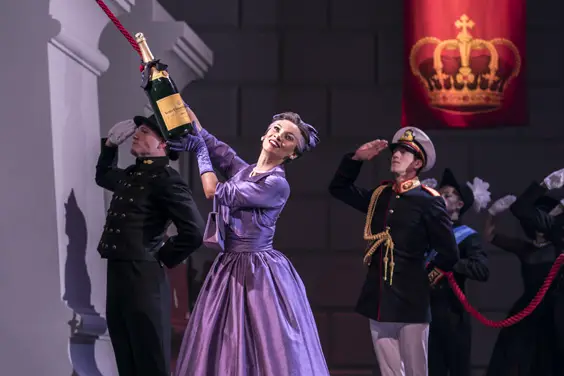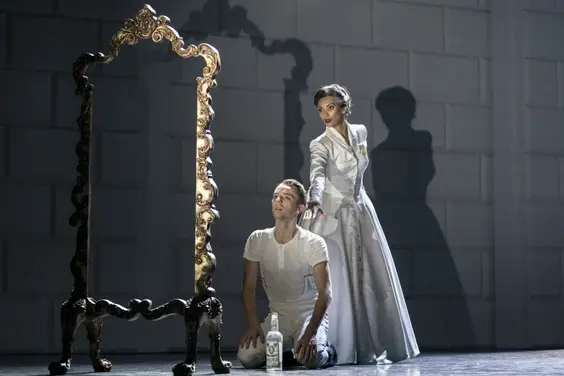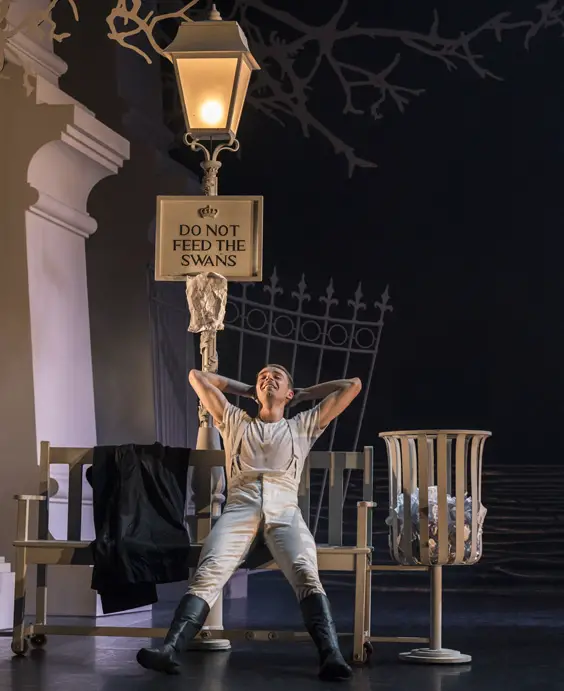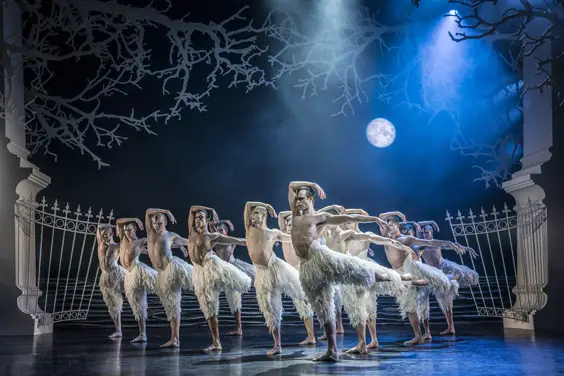Matthew Bourne’s Swan Lake – Review – Sheffield Lyceum
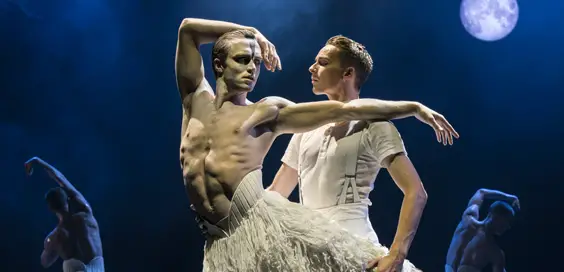
By Eve Luddington, May 2019
Warning: there are no tutus in this production!
Traditionalists were outraged when Matthew Bourne’s Swan Lake was first shown in 1995. By casting male dancers as the swans and making the central relationship a homosexual one, Bourne had broken the tradition that love in ballets only occurs between men and women. Some of the early audiences demanded their money back.
Yet no-one could deny that this East Ender with no formal ballet training had created a masterpiece of choreography and theatre which dramatises magnificently one of Tchaikovsky’s most inspired and moving scores.
Bourne’s Swan Lake has revolutionised the dance world in regard to style, content and the attitude to male dancers. If you’ve seen Billy Elliot, you’ll remember that the tear-jerking finale is of Billy playing the Swan in his production.
Since 2018, Bourne and his company, New Adventures, have been touring the country with a re-worked and updated version of his Swan Lake. At Sheffield Lyceum, I didn’t spot one member of the packed audience who remained seated at the curtain call, during the standing ovation to Sir Matthew Bourne (knighted in 2016) and the performers. I’d be amazed if anyone asked for a refund. How times change!
“Sparkling comic detail”
Every gesture and image develop the plot and our perception of the characters in this astonishing work. Brotherston’s design, with a panoply of settings, is as richly imagined as the storyline.
As the overture plays, the curtain rises onto a cold pillared chamber dominted by an enormous white bed. In it, lies the Prince, distressed by a nightmare. Behind him, the image of a swan appears. Enter an icily regal Queen, played with impeccable poise by Nicole Kabera, who keeps her son at arm’s length, bringing him no comfort.
A royal court ridden with pomp and ceremony is conveyed with sparkling comic detail. The Prince crawls out of his bed over the backs of his lackeys; a clockwork corgi is taken for walkies across the stage. Then the bed transforms into a palace balcony from which the Queen and her hesitant son greet the fawning crowds below with the royal wave, as Tchaikovsky’s music reaches a crescendo.
In the original Swan Lake, the Prince falls in love with a woman bewitched into a swan. In this, his gaze lingers over a naked male statue, just unveiled. He declines the attentions of various female suitors and only reluctantly accepts the blonde bimbo in pink thrust upon him by the Queen’s Private Secretary (Glenn Graham). She becomes The Girlfriend – who’s danced with hilarious unsophistication by Katrina Lyndon. An embarrassment to the royal family, she’s nevertheless considered better than no-one as a consort to the Prince, and certainly better than – perish the thought – a male partner.
“Quiet magic”
A glorious scene at the Opera House epitomises the imagination and wit of this production. As an audience member, it’s hard to know where to focus as Bourne’s audacious parody of a traditional ballet is danced on a stage next to the royal box in which the royal family and The Girlfriend sit. She’s dropping social clangers by the dozen; they’re trying to maintain their dignity.
It was only after this scene that I realised how many styles of dance Bourne uses. He has blown apart traditional notions of ballet, instead deftly matching genre to music, characterisation and mood.
As the Prince descends into a haze of drunken despair, we’re swept off to a seedy night club for a spot of disco-dancing and a sleazy fan dance. And then, via a vast backdrop of a Swan Vestas matchbox from which the swan flies off, to the lake and the chorus of swans in Act II.
Brotherston’s set and Paule Constable’s lighting design are sublime. The lake, swathed in mist, is lit by a full moon – and the Prince goes there, desolate, to commit suicide. First one swan glides across the water in a moment of quiet magic. Then the fanfare of swans moves in.
The dancers communicate brilliantly the awesome muscularity and strength of swans: they’re bare-chested, bare-footed, their waists to thighs a mass of white feathers. Their arms and hands stretch into slender necks and beaks or such powerful wings that one swipe can kill. They’re mesmerising and threatening. I will never again think of tutus when I see swans.
“Punishing role”
The Swan-leader’s solo is danced by Will Bozier with breathtaking skill and characterisation. The Prince is enthralled. So is the audience. When, eventually, the Swan leader allows contact, there’s a pas de deux so nuanced and exquisite it moved my companion to tears. The Prince, so reserved and awkward at court, is freed to be himself. Dominic North’s portrayal is fluid, passionate and graceful. He and Bozier make a compelling duo.
And then, with a mood change typical of this work, we have the splashy cygnet dance of adolescents strutting their stuff.
In conventional Swan Lake productions, the White Swan symbolises the romance of love; a Black Swan, often portrayed by the same dancer, reveals its darker side. Bourne chooses to put Bozier in black leather trousers as The Stranger, a gate-crasher to a royal ball. It’s a punishing role in its physical and mental demands. Bozier is magnificent.
The Stranger’s sexually charged dynamism rouses all the women guests, including the Queen, to frenzy. The Prince, watching, is in confused torment. Is this erotic woman-magnet the same being he fell for at the lake? When The Stranger finally turns to him, their homo-erotic dance of desperate attraction and repulsion is watched in horror by the onlookers and cut short, by gun fire.
“Rare theatrical experience”
As in the original, there is no happy ending to this Swan Lake. The story ends in madness – and the only resolution is death.
I was dazzled by both the production and the performance, and I know now why Bourne’s creation is a modern classic. The theme of forbidden love is dramatised, danced and characterised to its utmost limit, always by the New Adventures company.
It takes a special group of dancers to fulfil the demands of the production. Members come from a variety of dance and performance backgrounds; many have been with Bourne for years. Each of the lead roles can be played by two, three or four dancers. They perform with their very souls and carry the audience with them.
This is no simple fairy story; it’s a deeply felt expression of ‘transgressive’ love. It allows for different interpretations: I thought it was all in the Prince’s imagination, my companion disagreed. That didn’t matter; we both left the theatre wonderstruck by one of those rare theatrical experiences that will stay in your memory for a very long time.
